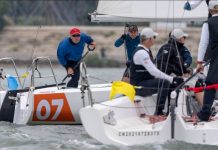FUSO Canter E-Cell impresses with more than 50,000 kilometres driven
64 percent lower costs compared with conventional diesel engines in customer field trials in Portugal
Powerful, high-torque electric motor
Targeted operating range of at least 100 kilometres achieved
Stuttgart/Porto – 64 percent savings in operating costs – this is the gratifying result of the final analysis of data from customer field trials with eight FUSO Canter E-Cell trucks in Portugal. Apart from the impressive savings in operating costs, the Canter E-Cell also scores points in terms of environmental aspects.
No CO2 emissions at the site – reduction by 37 percent compared to diesel, taking into account the current power production in Portugal. Thus, with the pre-production version of the electric-powered Canter, Fuso is on the right track to being able to meet the demand after electric-powered trucks in urban delivery traffic.
FUSO Canter E-Cell has stood the test of daily transport routines
With a wealth of experience that spans more than 40 years, FUSO has developed the new battery-powered and locally emission-free Canter E-Cell at the Daimler Trucks Centre of Competence for Hybrid Technology. The first light-duty truck built in small-series production operates without emissions and virtually without noise.
Consequently, it is predestined for use in areas that are sensitive to emissions and noise such as city centres, parks and pedestrian zones.
To prove this practicality of the Canter E-Cell, FUSO sent eight vehicles of the electrically powered Canter on a field trial in mid-2014. All eight vehicles travelled the roads of Portugal and were permanently monitored and analysed during the one-year field trial.
The Canter E-Cell trucks were equipped with platforms and box bodies. They were operated by couriers and freight forwarding agents as well as by municipalities and public works departments.
On the road for 51,500 kilometres without a problem – operating ranges of up to 109 km
On average, the electric Canter trucks travelled 50 kilometres a day, but ranges of up to 109 kilometres were achieved in practice. All in all, the eight vehicles travelled 51,500 kilometres without any problems. The most used Canter E-Cell was in service with “Transporta” parcel service company and completed a distance of over 14,000 kilometres during the one-year trial.
The range of the lithium-ion batteries stabilised at 100 km per charge. Charging the batteries on a 230-volt outlet takes about seven hours. That time is cut to just one hour on a quick charging system.
Savings in operating costs of up to 64 percent
Calculated on the basis of today’s cost of diesel fuel and electricity in Portugal, the trial produced savings in operating costs of up to 64 percent compared with a conventional diesel truck. In practical terms, this means a Canter diesel truck burns about 14.08 litres of diesel fuel over a distance of 100 kilometres, depending on set-up and freight, while the FUSO Canter E-Cell consumes 47.6 kWh of electricity over the same distance. The amount of savings will therefore differ depending on the costs of diesel and electricity in a particular country.
From municipalities and the postal service to parcel service companies
The customers experienced the Canter E-Cell as a strong and reliable concept that fully lives up to the requirements of urban delivery transport. The capabilities of the electric light-duty truck were tested under a wide range of conditions.
The City of Lisbon used the Canter E-Cell for the disposal of vegetation and waste, the City of Porto used it as a collection vehicle for recyclables, the City of Sintra for forest management and the cities of Abrantes and Cascais likewise for landscape maintenance. Transporta parcel service used the vehicle for door-to-door deliveries to households, energy supplier REN for transport purposes within the
industrial gas depots in the cities of Sines and Pombal. Finally, the Canter E-Cell also assisted the Portuguese postal service CTT with transport operations between the distribution centres of Lisbon and Coimbras.
The results of the practical tests show that the eight vehicles stood the test of daily use in short-distance delivery and city centre transport. With operating ranges of more than 100 kilometres, the Canter E-Cell trucks surpassed the average distance that many trucks used in light-duty distribution transport travel each day.
On the right track
“The results of the practical tests have shown that we are on the right track. During the trial phase, the customers experienced the Canter E-Cell as a strong and reliable concept that lives up to the requirements of daily urban delivery transport”, said Marc Llistosella, President and CEO of Mitsubishi FUSO Truck and Bus Corporation (MFTBC) and Head of Daimler Trucks Asia at the first presentation of the results.
The Portuguese government co-financed the research project through IAPMEI, the State Agency for Competitiveness and Innovation..
Six-tonne truck with a chassis load-bearing capacity of almost 3000 kilos
From the outside, the FUSO Canter E-Cell is only distinguished from its diesel-powered or diesel-electric powered brethren by the battery packs mounted to the two sides of the frame. An electric powertrain takes the place of the three-litre diesel engine behind the unchanged Canter cab. The permanent magnet motor sends 110 kilowatts (150 hp) of power to the rear axle via a one-speed transmission.
The chassis frame is approved for a total weight of six tonnes. The wheelbase of 4300 millimetres offers space for bodies up to 4.40 metres in length, the weight of which must be subtracted from the chassis load-bearing capacity of three tonnes. The remaining payload of a little over two tonnes is more than adequate for most transports in urban distribution operations.
Acceleration like a passenger car
A peak torque of 650 Newton metres accelerates the six-tonne truck almost like a passenger car. The driving pleasure is tremendous, as participants reported from the trial phase. The hefty torque is available instantly and at a traffic light leaves many a mid-range car behind.
As soon as the driver releases the accelerator pedal, the electronics switch to energy recovery mode, the effectiveness of which can be set to two different levels on the right-hand steering column stalk. In this case, the electric motor turns into a generator and feeds the exhaust brake energy generated during the rolling phase back to the lithium-ion batteries mounted to the frame. Drivers who use energy recovery in the Canter E-Cell regularly can achieve an operating range of more than 100 kilometres on one “tank filling”.
VSP warning system – vehicle sound for pedestrians
To prevent the Canter E-Cell’s silent rolling from creating hazards, the trucks are fitted with the acoustic VSP warning system (vehicle sound for pedestrians), which can be activated at the push of a button.
Very simple to drive and load
The Canter E-Cell is very simple to drive: The light-duty truck is started by turning the “ignition key”. As with a torque-converter automatic, the driver can select between the gear selector positions D, N, R and P. The practical crawler function in gear selector positions D and R is also comparable to an automatic transmission (“D” for Drive, “P” for Park, “N” for Neutral, “R” for Reverse).The driver can manoeuvre the Canter E-Cell simply by operating the brake and the accelerator pedal.
The electric Canter has been advanced continuously, starting with the first prototype on display at the IAA 2010. Today, it produces a rated output of 110 kW (150 hp) and a peak torque of 650 Nm from four lithium-ion battery packs with a formidable capacity of 48.4 kWh.
Good performance is ensured because an electric motor inherently produces its peak torque instantly upon start-up. As with all vehicles in this weight category, the top speed of the Canter E-Cell is limited to 90 km/h. The charging times and capacity of the batteries and consequently the operating range of the Canter E-Cell are being improved constantly.
The Canter E-Cell is built in Tramagal on a separate production line for prototype models. Since 2011, Daimler has invested about 27 million Euros in modern production facilities for a plant that celebrated its 50th anniversary last year.
The Tramagal plant, some 150 kilometres north-east of Lisbon, occupies an area of 39,900 square metres and is part of the global integrated production network of Daimler Trucks. More than 300 employees produce FUSO Canter trucks for about 30 European countries as well as for Israel, Morocco and Turkey. Almost 95 percent of the vehicles are bound for export. Since 2012, the employees in Tramagal have also produced the FUSO Canter Eco Hybrid, the hybrid version of the truck.
FUSO offers the Canter as a light-duty truck with a choice of three state-of-the-art powertrains: as the straightforward Canter with an economical diesel engine certified to current Euro VI and Euro 5b+ emissions standards, as the Canter Eco Hybrid with hybrid powertrain and now – still as part of customer field trials – as the Canter E-Cell with battery-electric powertrain.
MFTBC is the largest subsidiary of Daimler AG in Japan, employing a workforce of around 11,000 people. The company’s headquarters and its most important production plant are located in Kawasaki near Tokyo. With its FUSO brand, MFTBC accounts for more than 40 percent of Daimler’s global truck sales. Consequently, FUSO is the best-selling truck brand of the Daimler Group. The plant in Kawasaki produces more than 170,000 FUSO trucks and buses for the Japanese and international market annually. They are sold in more than 150 countries.








































